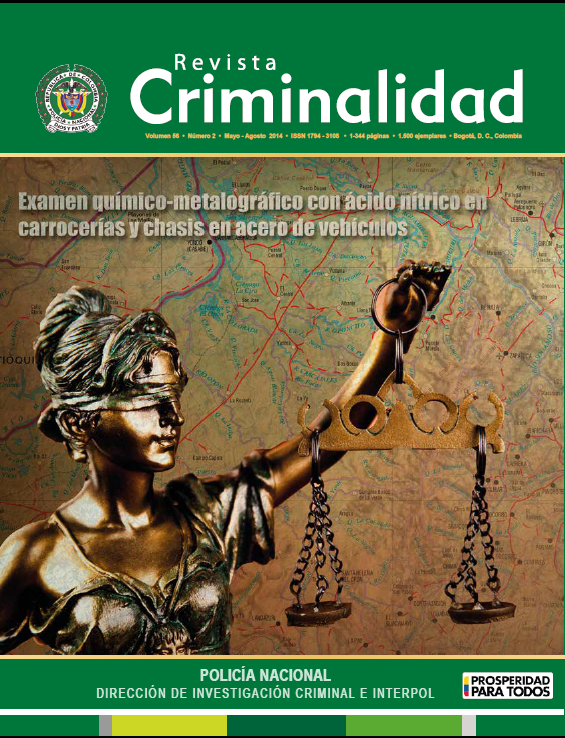Psicopatía y delincuencia: comparaciones y diferencias entre ofensores sexuales y delincuentes comunes en una cárcel chilena
DOI:
https://doi.org/10.47741/17943108.188Palabras clave:
psicopatía, PCL-R, delitos sexuales, delincuencia común, comparación entre delitosResumen
En esta investigación se compararon ofensores sexuales y delincuentes comunes de una cárcel chilena en relación con la psicopatía. La muestra constó de 57 agresores sexuales y 82 delincuentes comunes, todos condenados y recluidos en el Centro Cumplimiento Penitenciario de la ciudad de Puerto Montt, Chile. El instrumento utilizado en esta investigación fue el Psychopathy Checklist-Revised (PCL-R), de Robert Hare. Los resultados demuestran que el nivel de psicopatía parece no influir de manera significativa en el hecho de estar condenado por algún tipo de delito sexual; por otra parte, se aprecian niveles moderados de psicopatía en personas condenadas por delitos no violentos. A medida que aumentan las características psicopáticas se aprecia una asociación positiva con la participación en delitos violentos y/o de sangre. Se concluye que los ofensores sexuales y delincuentes comunes reincidentes presentan niveles mayores de psicopatía.
Descargas
Citas
Asscher, J. J., van Vugt, E. S., Stams, G. J. J., Deković, M., Eichelsheim, V. I. & Yousfi, S. (2011). The relationship between juvenile psychopathic traits, delinquency and (violent) recidivism: A meta-analysis. Journal of Child Psychology and Psychiatry, 52 (11), 1134-1143.
Barbaree, H. E., Seto, M. C., Langton, C. M. & Peacock, E. J. (2001). Evaluating the predictive accuracy of six risk assessment instruments for adult sex offenders. Criminal Justice and Behavior, 28: 490-521.
Brown, S. L. & Forth, A. E. (1997). Psychopathy and sexual assault: Static risk factors, emotional precursors, and rapist subtypes. Journal of Consulting and Clinical Psychology, 65: 848-857.
Ching, R. (2005). Psicología Forense. Principios Fundamentales. Costa Rica: EUNED.
Cleckley, H. (1976). The mask of sanity (5ª ed.). St. Louis, MO: Mosby.
Cornell, D. G., Warren, J., Hawk, G., Stafford, E., Oram, G. & Pine, D. (1996). Psychopathy of instrumental and reactive violent offenders. Journal of Consulting and Clinical Psychology, 64 (4): 783-90.
Craig, L., Browne, K., Beech, A. & Stringer, I. (2004, September). Personality characteristics associated with reconviction in sexual and violent offenders. The Journal of Forensic Psychiatry & Psychology, Vol. 15, No. 3: 532-551.
Firestone, P., Bradford, J. M., McCoy, M., Greenberg, D. M., Curry, S. & Larose, M. R. (1998). Recidivism in convicted rapists. Journal of the American Academy of Psychiatry and Law, 26: 185-200.
Firestone, P., Bradford, J. M., McCoy, M., Greenberg, D. M., Larose, M. R. & Curry, S. (1999). Prediction of recidivism in incest offenders. Journal of Interpersonal Violence, 14: 511-531.
Grann, M., Langström, N., Tengström, A. & Kullgren, G. (1999). Psychopathy (PCL-R) predicts violent recidivism among criminal offenders with personality disorders in Sweden. Law and Human Behavior, 23: 205-217.
Hanson, R. K. & Morton-Bourgon, K. E. (2005). The Characteristics of Persistent Sexual Offenders: A Meta-Analysis of Recidivism Studies. Journal of Consulting and Clinical Psychology, Vol. 73, No. 6: 1154-1163.
Hanson, R. K. & Harris, A. (1998). Dynamic predictors of sexual recidivism. Ottawa: Department of the Solicitor General of Canada.
Hanson, R. K. & Harris, A. (2000). Where should we intervene? Dynamic predictors of sexual offense recidivism. Criminal Justice and Behavior, 27: 6-35.
Hare, R. D. (1995). Psychopaths: New trends in research. Harvard Mental Health Letter, 12: 4-5.
Hare, R. D. (1998). 'Psychopaths and Their Nature: Implications for the Mental Health and Criminal Justice Systems'. In T. Millon, E. Simonsen, M. Birket-Smith & R. D. Davis (Eds.). Psychopathy: Antisocial, criminal and violent behavior (pp. 188-212). New York: Guilford.
Hare, R. D. (2003a). Sin conciencia: el inquietante mundo de los psicópatas que nos rodean. Editorial Paidós.
Hare, R. D. (2003b). Manual for the Revised Psychopathy Checklist (2ª ed.). Toronto, ON, C a n a d a : Multi-Health Systems.
Hare, R. D. & Jutai, J. (1983). Criminal history of the male psychopath: Some preliminary data. In K. T. Van Dusen & S. A. Mednick (Eds.). Prospective studies of crime and delinquency. Boston: Kluwer-Nijhoff.
Harris, G. T., Rice, M. E. & Cormier, C. A. (1991). Psychopathy and violent recidivism. Law and Human Behavior, 15: 625-637.
Harpur, T. J. & Hare, R. D. (1994). Assessment of psychopathy as a function of age. Journal of Abnormal Psychology, 103 (4): 604-609.
Hart, S. D., Kropp, P. R. & Hare, R. D. (1988). Performance of male psychopaths following condicional release from prison. Journal of Consulting and Clinical Psychology, 56: 227-232.
Hawes, S. W., Boccaccini, M. T. & Murrie, D. C. (2013). Psychopathy and the combination of psychopathy and sexual deviance as predictors of sexual recidivism: Meta-analytic findings using the Psychopathy Checklist-Revised. Psychological Assessment, 25: 233-243. doi:10.1037/a0030391.
Hemphill, J. F., Hare, R. D. & Wong, S. (1998). Psychopathy and recidivism: A review. Legal and Criminological Psychology, 3: 139-170.
Hernández, R., Fernández, C. & Baptista, P. (2008). Metodología de la investigación (4.ª ed.). México: McGraw-Hill.
Hildebrand, M., de Ruiter, C. & de Vogel, V. (2004). Psychopathy and sexual deviance in treated rapists: Association with sexual and nonsexual recidivism. Sexual Abuse: A Journal of Research and Treatment, 16: 1-24.
Kosson, D. S., Smith, S. S. & Newman, J. P. (1990). Evaluating the construct validity of psychopathy in Black and European American male inmates: Three preliminary studies. Journal of Abnormal Psychology, 99: 250-259.
Langström, N. & Grann, M. (2000). Risk for criminal recidivism among young sex offenders. Journal of Interpersonal Violence, 15: 855-871.
Laurell, J., Belfrage, H. & Hellström, Å (2010). Facets on the psychopathy checklist screening version and instrumental violence in forensic psychiatric patients. Criminal Behaviour and Mental Health, 20 (4): 285-294. doi:10.1002/cbm.779.
León, E. (2009). Determinación del nivel de fiabilidad y validez del PCL-R en población forense masculina chilena. Tesis de Maestría en Psicología Social, mención Psicología Jurídica. Universidad de Valparaíso, Chile (utilizada con autorización de la autora).
Melis, F. (2007). Aplicación de las técnicas psicodiagnósticas en el medio penitenciario. Anuario de Psicología Jurídica, Vol. 17: 179-207.
Olver, M. E. & Wong, S. C. P. (2006, January). Psychopathy, Sexual Deviance, and Recidivism Among Sex Offenders. Sexual Abuse: A Journal of Research and Treatment, Vol. 18, No. 1: 65-82.
Porter, S., Fairweather, D., Drugge, J., Hervé, H., Birt, A. & Boer, D. P. (2000). Profiles of psychopathy in incarcerated sexual offenders. Criminal Justice and Behavior, 27: 216-233.
Porter, S., Birt, A. & Boer, D. P. (2001). Investigation of the criminal and conditional release histories of Canadian federal offenders as a function of psychopathy and age. Law and Human Behavior, 25: 647-661.
Quinsey, V. L., Rice, M. E. & Harris, G. (1995). Actuarial prediction of sexual recidivism. Journal of Interpersonal Violence, 10: 85-105.
Redondo, S., Luque, E., Navarro, J. C. & Martínez, M. (2005). Análisis empírico de las características y los factores de riesgo de reincidencia en una muestra de agresores sexuales encarcelados. Anuario de Psicología Jurídica, Vol. 15: 135-157.
Rice, M. E., Harris, G. T. & Quinsey, V. L. (1990). A follow- up of rapists assessed in a maximum security psychiatric facility. Journal of Interpersonal Violence, 5: 435-448.
Robertiello, G. & Terry, K. (2007). Can we profile sex offenders? A review of sex offender typologies. Aggression and Violent Behavior, 12: 508-518.
Rosenberg, A., Abell, S. & Mackie, J. K. (2005). An Examination of the Relationship Between Child Sexual Offending and Psychopathy. Journal of Child Sexual Abuse, Vol. 14 (3): 49-66.
Salekin, R. T., Rogers, R. & Sewell, K. W. (1997). Construct validity of psychopathy in a female offender sample: A multitrait-multimethod evaluation. Journal of Abnormal Psychology, 106: 576-585.
Serin, R. C. & Amos, N. L. (1995). The role of psychopathy in the assessment of dangerousness. International Journal of Law and Psychiatry, 18: 231-238.
Serin, R. C., Malcolm, P. B., Khanna, A. & Barbaree, H. E. (1994). Psychopathy and deviant sexual arousal in incarcerated sexual offenders. Journal of Interpersonal Violence, 9: 3-11.
Sjöstedt, G. & Langström, N. (2002). Assessment of risk for criminal recidivism among rapists: A comparison of four different measures. Psychology, Crime, and Law, 8: 25-40.
Stadtland, C., Hollweg, M., Kleindienst, N., Dietl, J., Reich, U., Nedopil, N. (2005, March). Risk assessment and prediction of violent and sexual recidivism in sex offenders: Long-term predictive validity of four risk assessment instruments. The Journal of Forensic Psychiatry & Psychology, 16(1): 92-108.
Terry, K. J. (2006). Sexual offenses and offenders: Theory, practice and policy. Belmont, CA: Wadsworth.
Vess, J., Murphy, C. & Arkowitz, S. (2004, December). Clinical and demographic differences between sexually violent predators and other commitment types in a state forensic hospital. The Journal of Forensic Psychiatry & Psychology, Vol. 15, Nº 4: 669-681.
Vien, A. & Beech, A. R. (2006). Psychopathy: Theory, measurement, and treatment. Trauma, Violence, & Abuse, 7 (3): 155-174.
Williamson, S., Hare, R. D. & Wong, S. (1987). Violence: Criminal psychopaths and their victims. Canadian Journal of Behavioural Science, Vol. 9, Issue 4: 455-462.
Woodworth, M. & Porter, S. (2002). In cold blood: characteristics of criminal homicides as a function of psychopathy. Journal of Abnormal Psychology, 11 (3): 436-445.















